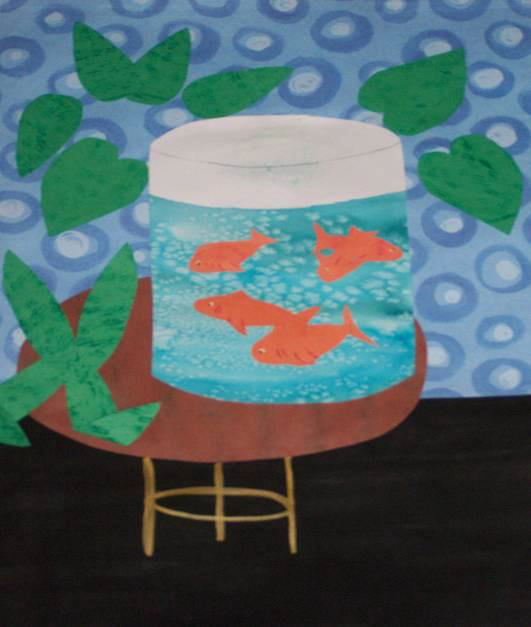Henri Matisse’s The Goldfish is a huge painting but children can have fun creating this miniature version using Sargent Art products.
Goal (Terminal Objective):
Students will learn about the work of Henri Matisse and the movement Fauvism. They will get a chance to work in a variety of media to create their own version of Matisse’s The Goldfish painting.
Objective:
The students will explore the media of watercolor and use the principles of pattern, texture, and space.
National Standards:
Visual Arts Grades K-4 Content Standard 1: Understanding and applying media, techniques, and processes
Visual Arts Grades K-4 Content Standard 2: Using knowledge of structures and functions
Visual Arts Grades K-4 Content Standard 3: Choosing and evaluating a range of subject matter, symbols, and ideas
Visual Arts Grades K-4 Content Standard 5: Reflecting upon and assessing the characteristics and merits of their work and the work of others
Purpose:
Students will learn about the style of Fauvism and Henri Matisse.
New Vocabulary:
Henri Matisse, fauvism, texture, texture rubbing, pattern
Materials:
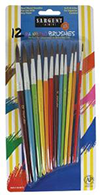
#56-6012 Natural Hair Rainbow Brush Assortment

#22-8426 Art-Time Premium Oval Watercolor Set
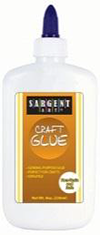
#22-1203 washable glue

#22-1506 metallic medium point peggable carton markers
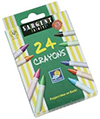
#55-0924 peggable box crayons
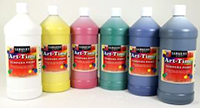
#17-63xx Art Time Tempera paint

#22-1565 4 ct. Black Fine Bullet Tip permanent markers

#23-5026 26 Sheet Watercolor Pad
black markers, watercolor paper, green paper, white or black paper, patterned scrap booking paper or wall paper samples, brown paper, orange paper, pencils, scissors, texture plate or items for a rubbing, table salt, containers for water
Time:
2 or 3 art periods depending on complexity of finished product.
Introduction and Motivation (Set):
Ask the students if they have ever had fish as a pet at home. Show students a picture of Henri Matisse’s The Goldfish painting.
Share some information about Matisse: born Dec. 31, 1869; died Nov. 3, 1954; was from France; was part of Fauvism (means the wild beast in French); loved pattern and bright colors.
Show the students a finished example of the project that they will be creating.
Instruction:
Students will begin by tracing a pattern of a goldfish bowl that the teacher has prepared using a pencil on the 9”x12” watercolor paper. It may be a cylinder like the one in Matisse’s painting or it may be the shape of a more traditional goldfish bowl. Discuss with the students how high the water should go in the bowl. Slightly wet the part of the bowl that is to be painted and use turquoise and blue watercolor paint to apply the water. Before the watercolor starts to dry, sprinkle a little table salt on top of the wet paint. Allow to dry.
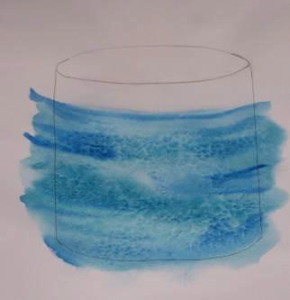
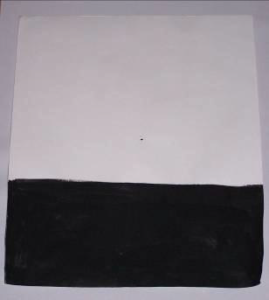
Select a 12”x12” patterned piece of scrap booking paper or use a wall paper sample. Place this paper at the top of the 12”x18” white paper and draw a line under the paper with a pencil. Paint this small strip that will show under the 12”x12” paper with black tempera paint. This step can be eliminated if you choose to use black paper instead of white. Also, students could paint their own pattern onto the “wall” and not use the scrap book paper or wall paper sample. After the black paint is dry, glue on the patterned paper thus creating a wall and floor.
Students will use the 6”x9” brown paper to create the table. Glue this into the “room” and use the liquid metal markers to draw on the table legs.
Make a texture rubbing on the 9”x12” green paper with crayon. Use either a texture plate or textured items under the paper and cover the entire green paper with rubbings. Fold the paper into fourths making sure that the textured side is folded under. Draw 3 or 4 simple leaf shapes with a pencil and cut out.
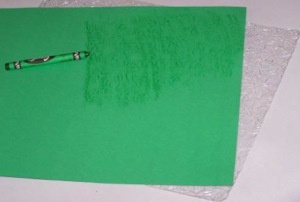
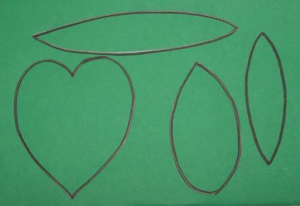
Cut out the fishbowl and place it on the table and place the leaves around the bowl.
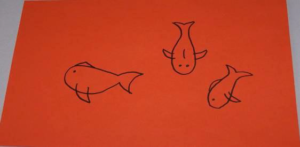
On the 6”x9” orange paper use a pencil to draw several goldfish. Make sure that they are not all going the same direction. Cut these out and glue them into the fishbowl.
Activities:
(1) Guided Practice:
- Students will create their fishbowl using watercolor paint and salt.
- Create the “room” by using a patterned paper and black tempera paint. This step may be substituted by using black paper and students could paint their own patterns.
- Use paper to create a table, leaves, and goldfish. Cut out these items and the watercolor fishbowl.
- After planning where items will go, glue each one down into the “room.”
(2) Independent Practice and Check for Understanding: Teacher will circulate around the students making sure that the objectives are being demonstrated, asking direct questions when understanding is not visible. Teacher will help with the work when necessary and reinforce students as they work.
(3) Closure: Students display their work and a critique will be utilized to look for strengths in successful projects.
Evaluation:
Teacher will evaluate the works individually based on the following criteria:
Level One — The finished project has the entire wall filled with pattern and a table that holds a fishbowl. The fishbowl does not have water going to the top. There are different shaped leaves with texture rubbing going around the fishbowl to resemble plants. There are several goldfish in the bowl going different directions. The finished picture shows a representation of Matisse’s The Goldfish painting. The craftsmanship is excellent.
Level Two — The finished project has most of the wall filled with pattern and a table that holds a fishbowl. The fishbowl does not have water going to the top. There are a few different shaped leaves with texture rubbing going around the fishbowl to resemble plants. There are a few goldfish in the bowl going different directions. The finished picture shows a representation of Matisse’s The Goldfish painting. The craftsmanship is good.
Level Three — The finished project has some of the wall filled with pattern and the table that holds a fishbowl is too small. The fishbowl has water going to the top. There are a few leaves but they are the same shape. There are a couple of goldfish in the bowl going different directions. The finished picture does not show a representation of Matisse’s The Goldfish painting. The craftsmanship is variable.
Level Four — The finished project does not have the wall filled with pattern. The table that holds a fishbowl has not been cut into an oval and/or is missing the legs. The fishbowl has water going to the top. There are a few leaves but they are too small and are the same shape. There is one or less goldfish in the bowl. The finished picture does not show a representation of Matisse’s The Goldfish painting. The craftsmanship is poor.
Cross Curriculum: Language Arts:
Students will write about how to care for goldfish, or any pet that they have or would like to have.
Extension:
If time permits, students could use Matisse’s cut paper compositions for inspiration to create their own.
Resources:
www.artofcolour.com/…/matisse/matisse3.html
www.ovationtv.com/…/henri_matisse_372x280.jpg
www.chess-theory.com/…/01501_henri_matisse.jpg
http://www.abcgallery.com/M/matisse/matisse.html
Art Consultant



